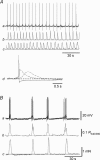Spontaneous activity of lower urinary tract smooth muscles: correlation between ion channels and tissue function
- PMID: 16210349
- PMCID: PMC1464291
- DOI: 10.1113/jphysiol.2005.097311
Spontaneous activity of lower urinary tract smooth muscles: correlation between ion channels and tissue function
Abstract
Smooth muscles from the urethra and bladder display characteristic patterns of spontaneous contractile activity in the filling phase of the micturition cycle. Tonic contractions are seen in the urethral smooth muscles, and phasic contractions occur in the detrusor. Overactivity in the detrusor is a common clinical problem. The ion channels in the smooth muscle membranes play an important role in determining the functional properties, and are obvious targets for treatment of the overactive bladder. Recent evidence suggests that interstitial cells may also play a role in determining the pattern of spontaneous activity, although their precise role is less well established in the urinary tract than in the gut. The ion channels involved in these cells are also of interest. This review discusses what is known of ion channels in these tissues, and their implications for function.
Figures









References
-
- Abrams P. The overactive bladder and its treatments: consensus conference. BJU Int. 2000;85(Suppl 2)
-
- Andersson KE, Garcia-Pascual A, Forman A, Tottrup A. Non-adrenergic, non-cholinergic nerve-mediated relaxation of rabbit urethra is caused by nitric oxide. Acta Physiol Scand. 1991;141:133–134. - PubMed
-
- Brading AF. A myogenic basis for the overactive bladder. Urology. 1997;50:57–67. discussion 68–73. - PubMed
-
- Brading AF, Teramoto T, Nakayama S, Bramich N, Inoue R, Fujii K, Mostwin J. The relationship between the electrophysiological properties of lower urinary tract smooth muscles and their function in vivo. In: Bolton TB, Tonita T, editors. Smooth Muscle Excitation. London: Academic Press; 1996. pp. 403–415.
-
- Bradley JE, Anderson UA, Woolsey SM, Thornbury KD, McHale NG, Hollywood MA. Characterization of T-type calcium current and its contribution to electrical activity in rabbit urethra. Am J Physiol Cell Physiol. 2004;286:C1078–C1088. - PubMed
Publication types
MeSH terms
Substances
LinkOut - more resources
Full Text Sources
Other Literature Sources

